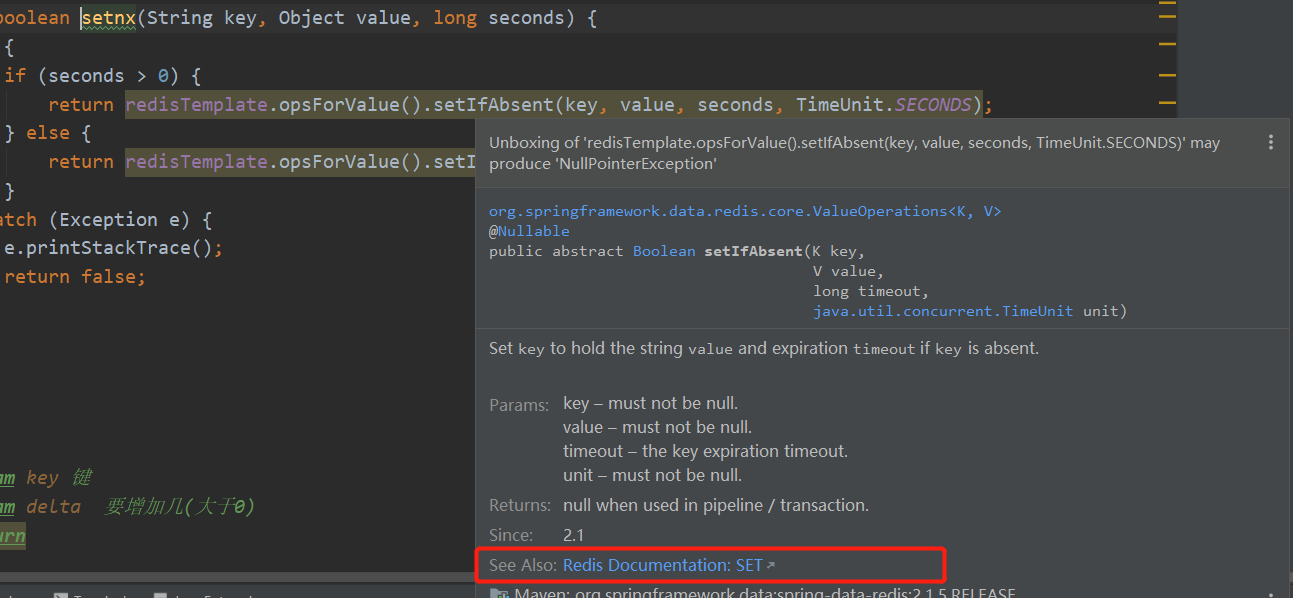利用@see、@link增强程序可读性
诸多原因,我们的程序往往解释不了它自己。
即使程序可以解释自己,那么,谁会用它?它跟谁有关系? 这些就用到javadoc中的@see、@link了。这两个注解实现在javadoc注释里链接代码,方便我们追溯程序。
经常看java源码的同学可能注意到了,java源码里有很多的@see、@link,来辅助我们查阅。
比如下面spring-data-redis.jar中org.springframework.data.redis.core.ValueOperations<K, V>#setIfAbsent
/** * Set {@code key} to hold the string {@code value} and expiration {@code timeout} if {@code key} is absent. * * @param key must not be {@literal null}. * @param value must not be {@literal null}. * @param timeout the key expiration timeout. * @param unit must not be {@literal null}. * @return {@literal null} when used in pipeline / transaction. * @since 2.1 * @see <a href="http://redis.io/commands/set">Redis Documentation: SET</a> */ @Nullable Boolean setIfAbsent(K key, V value, long timeout, TimeUnit unit);
调用这个方法的地方就可以看到其javadoc注释。

再例如rt.jar包里 java.math.BigDecimal#equals方法的javadoc,其中有{@link #compareTo(BigDecimal) compareTo},有@see
/** * Compares this {@code BigDecimal} with the specified * {@code Object} for equality. Unlike {@link * #compareTo(BigDecimal) compareTo}, this method considers two * {@code BigDecimal} objects equal only if they are equal in * value and scale (thus 2.0 is not equal to 2.00 when compared by * this method). * * @param x {@code Object} to which this {@code BigDecimal} is * to be compared. * @return {@code true} if and only if the specified {@code Object} is a * {@code BigDecimal} whose value and scale are equal to this * {@code BigDecimal}'s. * @see #compareTo(java.math.BigDecimal) * @see #hashCode */ @Override public boolean equals(Object x) {

| 用途 | 相同点 | 不同点 | |
| @see |
|
@see com.....XXXClass @see com.....XXXClass#XXXMethod @see <a href="url">url</a> |
与注释文本是分开的,要另起一行写 |
| @link |
|
{@link com.....XXXClass [可选标题]} {@link com.....XXXClass#XXXMethod [可选标题]} |
使用在注释文字里,要包在{}里 |
使用@see为class添加注释
/** * 企业开票申请单的状态枚举 * @see com.emax.zhenghe.rpcapi.modules.bill.vo.EnterpriseInvoiceApplyVO#billStatus * @author zhangguozhan * @date 2021-5-20 17:56 * @note 指毛病易,列优点难。区别在于,一个是本能,一个是能力。 */ @Getter @AllArgsConstructor public enum InvoiceApplyStatusEnum { 。。。 }
效果:

/** * 基于MDC+Filter的跨应用分布式日志追踪解决方案 * * @see <a href="https://www.cnblogs.com/iwangjie/p/14811865.html">基于SLF4J的MDC机制和Dubbo的Filter机制,实现分布式系统的日志全链路追踪</a> */ @Slf4j @Activate(order = 999, group = {Constants.PROVIDER_PROTOCOL, Constants.CONSUMER_PROTOCOL}) public class DubboTraceFilter implements Filter { ...
使用@link为class的成员属性添加注释
public class EnterpriseOnlineAuthVO { 。。。 /** * 子商户类型,参见{@link com.emax.channel.base.enums.PlatformMerchantEnum} */private String merchantType; 。。。 }
效果:

使用@see为class的成员属性添加注释
public class EnterpriseOnlineAuthVO { 。。。 /** * 子商户类型 * @see com.emax.channel.base.enums.PlatformMerchantEnum */ private String merchantType; 。。。 }
效果:

当看到一些不好的代码时,会发现我还算优秀;当看到优秀的代码时,也才意识到持续学习的重要!--buguge
本文来自博客园,转载请注明原文链接:https://www.cnblogs.com/buguge/p/14799415.html




